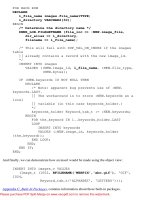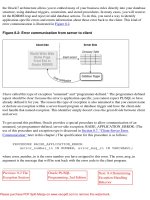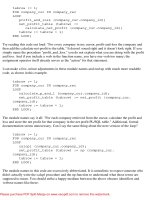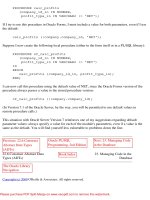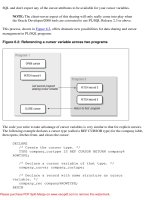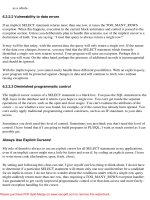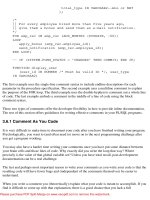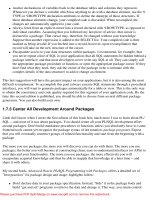Oracle PL/SQL Language Pocket Reference- P9
Bạn đang xem bản rút gọn của tài liệu. Xem và tải ngay bản đầy đủ của tài liệu tại đây (211.69 KB, 50 trang )
total_type IN VARCHAR2--ALL or NET
);
/*
|| For every employee hired more than five years ago,
|| give them a bonus and send them an e-mail notification.
*/
FOR emp_rec IN emp_cur (ADD_MONTHS (SYSDATE, -60))
LOOP
apply_bonus (emp_rec.employee_id);
send_notification (emp_rec.employee_id);
END LOOP;
-- IF :SYSTEM.FORM_STATUS = 'CHANGED' THEN COMMIT; END IF;
FUNCTION display_user
(user_id IN NUMBER /* Must be valid ID */, user_type
IN VARCHAR2)
The first example uses the single-line comment syntax to include endline descriptions for each
parameter in the procedure specification. The second example uses a multiline comment to explain
the purpose of the FOR loop. The third example uses the double-hyphen to comment out a whole line
of code. The last example embeds a comment in the middle of a line of code using the block
comment syntax.
These two types of comments offer the developer flexibility in how to provide inline documentation.
The rest of this section offers guidelines for writing effective comments in your PL/SQL programs.
3.6.1 Comment As You Code
It is very difficult to make time to document your code after you have finished writing your program.
Psychologically, you want to (and often need to) move on to the next programming challenge after
you get a program working.
You may also have a harder time writing your comments once you have put some distance between
your brain cells and those lines of code. Why exactly did you write the loop that way? Where
precisely is the value of that global variable set? Unless you have total recall, post-development
documentation can be a real challenge.
The last and perhaps most important reason to write your comments as you write your code is that the
resulting code will have fewer bugs and (independent of the comments themselves) be easier to
understand.
When you write a comment you (theoretically) explain what your code is meant to accomplish. If you
find it difficult to come up with that explanation, there is a good chance that you lack a full
Please purchase PDF Split-Merge on www.verypdf.com to remove this watermark.
understanding of what the program does or should do.
The effort that you make to come up with the right comment will certainly improve your
comprehension, and may also result in code correction. In this sense, good inline documentation can
be as beneficial as a review of your code by a peer. In both cases, the explanation will reveal
important information about your program.
3.6.2 Explain the Why -- Not the How -- of Your Program
What do you think of the comments in the following Oracle Forms trigger code?
-- If the total compensation is more than the maximum...
IF :employee.total_comp > maximum_salary
THEN
-- Inform the user of the problem.
MESSAGE ('Total compensation exceeds maximum. Please
re-enter!');
-- Reset the counter to zero.
:employee.comp_counter := 0;
-- Raise the exception to stop trigger processing.
RAISE FORM_TRIGGER_FAILURE;
END IF;
None of these comments add anything to the comprehension of the code. Each comment simply
restates the line of code, which in most cases is self-explanatory.
Avoid adding comments simply so that you can say, "Yes, I documented my code!" Rely as much as
possible on the structure and layout of the code itself to express the meaning of the program. Reserve
your comments to explain the Why of your code: What business rule is it meant to implement? Why
did you need to implement a certain requirement in a certain way?
In addition, use comments to translate internal, computer-language terminology into something
meaningful for the application. Suppose you are using Oracle Forms GLOBAL variables to keep
track of a list of names entered. Does the following comment explain the purpose of the code or
simply restate what the code is doing?
/* Set the number of elements to zero. */
:GLOBAL.num_elements := 0;
Once again, the comment adds no value. Does the next comment offer additional information?
/* Empty the list of names. */
:GLOBAL.num_elements := 0;
Please purchase PDF Split-Merge on www.verypdf.com to remove this watermark.
This comment actually explains the purpose of the assignment of the global to zero. By setting the
number of elements to zero, I will have effectively emptied the list. This comment has translated the
"computer lingo" into a description of the effect of the statement. Of course, you would be even
better off hiding the fact that you use this particular global variable to empty a list and instead build a
procedure as follows:
PROCEDURE empty_list IS
BEGIN
:GLOBAL.num_elements := 0;
END;
Then to empty a list you would not need any comment at all. You could simply include the statement:
empty_list;
and the meaning would be perfectly clear.
3.6.3 Make Comments Easy to Enter and Maintain
You shouldn't spend a lot of time formatting your comments. You need to develop a style that is
clean and easy to read, but also easy to maintain. When you have to change a comment, you shouldn't
have to reformat every line in the comment. Lots of fancy formatting is a good indication that you
have a high-maintenance documentation style. The following block comment is a maintenance
nightmare:
/*
===========================================================
| Parameter Description
|
|
|
| company_id The primary key to company
|
| start_date Start date used for date range
|
| end_date End date for date range
|
===========================================================
*/
The right-justified vertical lines and column formatting for the parameters require way too much
effort to enter and maintain. What happens if you add a parameter with a very long name? What if
you need to write a longer description? A simpler and more maintainable version of this comment
might be:
Please purchase PDF Split-Merge on www.verypdf.com to remove this watermark.
/*
===========================================================
| Parameter - Description
|
| company_id - The primary key to company
| start_date - Start date used for date range
| end_date - End date for date range
===========================================================
*/
I like to use the following format for my block comments:
/*
|| I put the slash-asterisk that starts the comment on a
line all by
|| itself. Then I start each line in the comment block
with a double
|| vertical bar to highlight the presence of the comment.
Finally,
|| I place the asterisk-slash on a line all by itself.
*/
On the negative side, the vertical bars have to be erased whenever I reformat the lines, but that isn't
too much of an effort. On the positive side, those vertical bars make it very easy for a programmer
who is scanning the left side of the code to pick out the comments.
I put the comment markers on their own lines to increase the whitespace in my program and set off
the comment. That way I can avoid "heavy" horizontal lines full of delimiters, such as asterisks or
dashes, and avoid having to match the longest line in the comment.
3.6.4 Maintain Indentation
Inline commentary should reinforce the indentation and therefore the logical structure of the program.
For example, it is very easy to find the comments in the make_array procedures shown below. I do
not use any double-hyphens, so the slash-asterisk sequences stand out nicely. In addition, all
comments start in the first column, so I can easily scan down the left-hand side of the program and
pick out the documentation:
PROCEDURE make_array (num_rows_in IN INTEGER)
/* Create an array of specified numbers of rows */
IS
/* Handles to Oracle Forms structures */
col_id GROUPCOLUMN;
rg_id RECORDGROUP;
Please purchase PDF Split-Merge on www.verypdf.com to remove this watermark.
BEGIN
/* Create new record group and column */
rg_id := CREATE_GROUP ('array');
col_id := ADD_GROUP_COLUMN ('col');
/*
|| Use a loop to create the specified number of rows and
|| set the value in each cell.
*/
FOR row_index IN 1 .. num_rows_in
LOOP
/* Create a row at the end of the group to accept data */
ADD_GROUP_ROW (return_value, END_OF_GROUP);
FOR col_index IN 1 .. num_columns_in
LOOP
/* Set the initial value in the cell */
SET_GROUP_NUMBER_CELL (col_id, row_index, 0);
END LOOP;
END LOOP;
END;
The problem with these comments is precisely that they do all start in the first column, regardless of
the code they describe. The most glaring example of this formatting "disconnect" comes in the inner
loop, repeated below:
FOR col_index IN 1 .. num_columns_in
LOOP
/* Set the initial value in the cell */
SET_GROUP_NUMBER_CELL (col_id, row_index, 0);
END LOOP;
Your eye follows the three-space indentation very smoothly into the loop and then you are forced to
move all the way to the left to pick up the comment. This format disrupts your reading of the code
and therefore its readability. The code loses some of its ability to communicate the logical flow "at a
glance," because the physical sense of indentation as logical flow is marred by the comments. Finally,
you may end up writing full-line comments which are much longer than the code they appear next to,
further distorting the code.
Your comments should always be indented at the same level as the code which they describe.
Assuming the comments come before the code itself, those lines of descriptive text will initiate the
indentation at that logical level, which will also reinforce that structure. The make_array procedure,
properly indented, is shown below:
PROCEDURE make_array (num_rows_in IN INTEGER)
/* Create an array of specified numbers of rows */
IS
Please purchase PDF Split-Merge on www.verypdf.com to remove this watermark.
/* Handles to Oracle Forms structures */
col_id GROUPCOLUMN;
rg_id RECORDGROUP;
BEGIN
/* Create new record group and column */
rg_id := CREATE_GROUP ('array');
col_id := ADD_GROUP_COLUMN ('col');
/*
|| Use a loop to create the specified number of rows
and
|| set the value in each cell.
*/
FOR row_index IN 1 .. num_rows_in
LOOP
/* Create a row at the end of the group to accept
data */
ADD_GROUP_ROW (return_value, END_OF_GROUP);
FOR col_index IN 1 .. num_columns_in
LOOP
/* Set the initial value in the cell */
SET_GROUP_NUMBER_CELL (col_id, row_index, 0);
END LOOP;
END LOOP;
END;
END LOOP;
END LOOP;
END;
3.6.5 Comment Declaration Statements
I propose the following simple rule for documenting declaration statements:
Provide a comment for each and every declaration.
Does that sound excessive? Well, I must admit that I do not follow this guideline at all times, but I
bet people who read my code wish I had. The declaration of a variable which seems to me to be
perfectly clear may be a source of abiding confusion for others. Like many other people, I still have
difficulty understanding that what is obvious to me is not necessarily obvious to someone else.
Consider the declaration section in the next example. The commenting style is inconsistent. I use
double-hyphens for a two-line comment; then I use the standard block format to provide information
about three variables all at once. I provide comments for some variables, but not for others. It's hard
to make sense of the various declaration statements:
Please purchase PDF Split-Merge on www.verypdf.com to remove this watermark.
DECLARE
-- Assume a maximum string length of 1000 for a line
of text.
text_line VARCHAR2 (1000);
len_text NUMBER;
/*
|| Variables used to keep track of string scan:
|| atomic_count - running count of atomics scanned.
|| still_scanning - Boolean variable controls WHILE
loop.
*/
atomic_count NUMBER := 1;
still_scanning BOOLEAN;
BEGIN
Let's recast this declaration section using my proposed guideline: a comment for each declaration
statement. In the result shown below, the declaration section is now longer than the first version, but
it uses whitespace more effectively. Each declaration has its own comment, set off by a blank line if a
single-line comment:
DECLARE
/* Assume a maximum string length of 1000 for a line
of text. */
text_line VARCHAR2 (1000);
/* Calculate length of string at time of declaration */
len_string NUMBER;
/* Running count of number of atomics scanned */
atomic_count NUMBER := 1;
/* Boolean variable that controls WHILE loop */
still_scanning BOOLEAN ;
BEGIN
Previous: 3.5 Formatting
Packages
Oracle PL/SQL
Programming, 2nd Edition
Next: 3.7 Documenting the
Entire Package
3.5 Formatting Packages
Book Index
3.7 Documenting the Entire
Package
The Oracle Library
Navigation
Please purchase PDF Split-Merge on www.verypdf.com to remove this watermark.
Copyright (c) 2000 O'Reilly & Associates. All rights reserved.
Please purchase PDF Split-Merge on www.verypdf.com to remove this watermark.
Previous: 3.4 Formatting
PL/SQL Blocks
Chapter 3
Effective Coding Style
Next: 3.6 Using Comments
Effectively
3.5 Formatting Packages
A package is a collection of related objects, including variables, TYPE statements (to define
structures for records, tables, and cursors), exceptions, and modules. We have already covered
structuring all the different objects which make up a package. Now, let's take a look at how to
structure the package itself.
A package has both a specification and a body. The package specification contains the declarations or
definitions of all those objects that are visible outside of the package -- the public objects. This means
that the objects can be accessed by any account that has been granted EXECUTE authority on the
package. The package body contains the implementation of all cursors and modules defined in the
specification, and the additional declaration and implementation of all other package objects. If an
object, such as a string variable, is declared in the body and not in the package, then any module in
the package can reference that variable, but no program outside of the package can see it. That
variable is invisible or private to the package.
The first point to make about the package structure is that all objects declared in the specification
exist within the context of the package and so should be indented from the PACKAGE statement
itself, as shown below:
PACKAGE rg_select
IS
list_name VARCHAR2(60);
PROCEDURE init_list
(item_name_in IN VARCHAR2,
fill_action_in IN VARCHAR2 := 'IMMEDIATE');
PROCEDURE delete_list;
PROCEDURE clear_list;
END rg_select;
The same is true for the package body. I suggest that you always include a label for the END
statement in a package so that you can easily connect up that END with the end of the package as a
Please purchase PDF Split-Merge on www.verypdf.com to remove this watermark.
whole. I place the IS keyword on a new line to set off the first declaration in the package from the
name of the package. You could always use a blank line. Notice that I use blank lines in rg_select to
segregate different modules which are related by function. I think that logical grouping is always
preferable to an arbitrary grouping such as alphabetical order.
The other important element in formatting a package is the order in which objects are listed in the
package. I generally list objects in the order of complexity of their structure, as follows:
●
Scalar variables, such as a VARCHAR2 declaration
●
Complex datatypes, such as records and tables
●
Database-related declarations, such as cursors
●
Named exceptions
●
Modules (procedures and functions)
As with simple variable declarations, I sometimes have many different but related objects in my
package. If so, I might group those types of objects together. But within that grouping, I still follow
the above order.
Previous: 3.4 Formatting
PL/SQL Blocks
Oracle PL/SQL
Programming, 2nd Edition
Next: 3.6 Using Comments
Effectively
3.4 Formatting PL/SQL
Blocks
Book Index
3.6 Using Comments
Effectively
The Oracle Library
Navigation
Copyright (c) 2000 O'Reilly & Associates. All rights reserved.
Please purchase PDF Split-Merge on www.verypdf.com to remove this watermark.
Previous: 3.3 Formatting
Control Structures
Chapter 3
Effective Coding Style
Next: 3.5 Formatting
Packages
3.4 Formatting PL/SQL Blocks
As I've outlined in Chapter 2, every PL/SQL program is structured as a block containing up to four
sections:
●
Header
●
Declaration section
●
Executable section
●
Exception section
The PL/SQL block structure forms the backbone of your code. A consistent formatting style for the
block, therefore, is critical. This formatting should make clear these different sections. (See
Chapter
15, Procedures and Functions, for more information about the block structure.)
Consider the following function:
FUNCTION
company_name (company_id_in IN company.company_id%
TYPE) RETURN
VARCHAR2 IS cname company.company_id%TYPE; BEGIN
SELECT name INTO cname FROM company
WHERE company_id = company_id_in;
RETURN cname;
EXCEPTION WHEN NO_DATA_FOUND THEN RETURN NULL; END;
You know that this program is a function because the first word in the program is FUNCTION. Other
than that, however, it is very difficult to follow the structure of this program. Where is the declaration
section? Where does the executable section begin and end?
Here is that same function after we apply some straightforward formatting rules to it:
FUNCTION company_name (company_id_in IN company.company_id
%TYPE)
Please purchase PDF Split-Merge on www.verypdf.com to remove this watermark.
RETURN VARCHAR2
IS
cname company.company_id%TYPE;
BEGIN
SELECT name INTO cname FROM company
WHERE company_id = company_id_in;
RETURN cname;
EXCEPTION
WHEN NO_DATA_FOUND
THEN
RETURN NULL;
END;
Now it is easy to see that the header of the function consists of:
FUNCTION company_name (company_id_in IN company.company_id
%TYPE)
RETURN VARCHAR2
The declaration section, which comes after the IS and before the BEGIN, clearly consists of a single
declaration of the cname variable. The executable section consists of all the statements after the
BEGIN and before the EXCEPTION statement; these are indented in from the BEGIN. Finally, the
exception section shows a single specific exception handler and a WHEN OTHERS exception.
Generally, indent the statements for a given section from the reserved words which initiate the
section. You can also include a blank line before each section, as I do above, for the executable
section (before BEGIN) and the exception section (before EXCEPTION). I usually place the IS
keyword on its own line to clearly differentiate between the header of a module and its declaration
section.
Previous: 3.3 Formatting
Control Structures
Oracle PL/SQL
Programming, 2nd Edition
Next: 3.5 Formatting
Packages
3.3 Formatting Control
Structures
Book Index
3.5 Formatting Packages
The Oracle Library
Navigation
Copyright (c) 2000 O'Reilly & Associates. All rights reserved.
Please purchase PDF Split-Merge on www.verypdf.com to remove this watermark.
Previous: 3.2 Formatting
SQL Statements
Chapter 3
Effective Coding Style
Next: 3.4 Formatting PL/
SQL Blocks
3.3 Formatting Control Structures
The control structures in your program are the most direct representation of the logic needed to implement your
specifications. The format of these control structures, therefore, will have a significant impact on the readability of your
code.
Indentation is the most important element of control structure layout. Always keep statements of the same "logical level"
at the same indentation level. Let's see what this means for the various control structures of PL/SQL.
3.3.1 Formatting IF Statements
This conditional construct comes in three flavors:
IF <expression>
END IF;
IF <expression>
ELSE
END IF;
IF <expression>
ELSEIF <expression>
ELSE
END IF;
In general, the IF statement is composed of clauses in which there is a Boolean expression or condition and a section of
code executed when that condition evaluates to TRUE.
So if you want to use indentation to reveal the logical structure of the simplest form of the IF statement (IF-END IF), I
suggest one of these two styles:
New Line for THEN Same Line for THEN
IF <expression>
THEN
executable_statements;
END IF;
IF <expression> THEN
executable_statements
END IF;
IF <expression>
THEN
executable_statements;
ELSE
else_executable_statements;
END IF;
IF <expression> THEN
executable_statements
ELSE
else_executable_statements;
END IF;
Please purchase PDF Split-Merge on www.verypdf.com to remove this watermark.
IF <expression>1
THEN
executable_statements1;
ELSEIF <expression2>
THEN
executable_statements2;
...
ELSEIF <expressionN>
THEN
executable_statementsN;
ELSE
else_executable_statements;
END IF;
IF <expression>1 THEN
executable_statements1;
ELSEIF <expression2> THEN
executable_statements2;
...
ELSEIF <expressionN> THEN
executable_statementsN;
ELSE
else_executable_statements;
END IF;
Notice that in both versions the executable statements are indented three spaces from the column in which the IF and
END IF reserved words are found. The only difference between the two formats is the placement of the THEN reserved
word. I prefer the new line format, in which the THEN appears on a line by itself after the IF condition. This format
provides more whitespace than the other. I could create the whitespace by using a blank, rather than indenting three
spaces, but then the executable statements for the IF clause are made distinct from the condition -- and they are logically
connected. Let's examine some actual code to get a better sense of the differences.
The following example shows proper IF statement indentation with THEN on the same line:
IF max_sales > 2000 THEN
notify_accounting ('over_limit');
RAISE FORM_TRIGGER_FAILURE;
END IF;
This code has proper IF statement indentation with THEN on the next line:
IF max_sales > 2000
THEN
notify_accounting ('over_limit');
RAISE FORM_TRIGGER_FAILURE;
END IF;
3.3.2 Formatting Loops
You are going to be writing many loops in your PL/SQL programs, and they will usually surround some of the most
complicated code in your application. For this reason, the format you use to structure your loops will make a critical
difference in the overall comprehensibility of your programs.
PL/SQL offers the following kinds of loops:
●
Infinite or simple loop
●
WHILE loop
●
Indexed FOR loop (numeric and cursor)
Each loop has a loop boundary (begin and end statements) and a loop body. The loop body should be indented from the
Please purchase PDF Split-Merge on www.verypdf.com to remove this watermark.
boundary (again, I recommend three spaces of indentation).
As with the IF statement, you can either choose to leave the LOOP reserved word at the end of the line containing the
WHILE and FOR statements or place it on the next line. I prefer the latter, because then both the LOOP and END LOOP
reserved words appear at the same column position (indentation) in the program.
Here are my recommendations for formatting your loops:
●
The infinite or simple loop:
LOOP
executable_statements;
END LOOP;
●
The WHILE loop:
WHILE condition
LOOP
executable_statements;
END LOOP;
●
The numeric and cursor FOR loops:
FOR for_index IN low_value .. high_value
LOOP
executable_statements;
END LOOP;
FOR record_index IN my_cursor
LOOP
executable_statements;
END LOOP;
3.3.3 Formatting Exception Handlers
PL/SQL provides a very powerful facility for dealing with errors. An entirely separate exception section contains one or
more "handlers" to trap exceptions and execute code when that exception occurs. Logically, the exception section is
structured like a conditional CASE statement (which, by the way, is not supported by PL/SQL).
As you might expect, the format for the exception section should resemble that of an IF statement. Here is a general
example of the exception section:
EXCEPTION
WHEN NO_DATA_FOUND
THEN
executable_statements1;
WHEN DUP_VAL_ON_INDEX
THEN
executable_statements1;
...
WHEN OTHERS
THEN
Please purchase PDF Split-Merge on www.verypdf.com to remove this watermark.
otherwise_code;
END;
Instead of an IF or ELSIF keyword, the exception handler uses the word WHEN. In place of a condition (Boolean
expression), the WHEN clause lists an exception name followed by a THEN and finally the executable statements for that
exception. In place of ELSE, the exception section offers a WHEN OTHERS clause.
Follow these guidelines:
●
Indent each WHEN clause in from the EXCEPTION keyword that indicates the start of the exception section, as
I've shown above. Place the THEN directly below the WHEN.
●
Indent all the executable statements for that handler in from the THEN keyword.
●
Place a blank line before each WHEN (except for the first).
Previous: 3.2 Formatting
SQL Statements
Oracle PL/SQL
Programming, 2nd Edition
Next: 3.4 Formatting PL/
SQL Blocks
3.2 Formatting SQL
Statements
Book Index
3.4 Formatting PL/SQL
Blocks
The Oracle Library
Navigation
Copyright (c) 2000 O'Reilly & Associates. All rights reserved.
Please purchase PDF Split-Merge on www.verypdf.com to remove this watermark.
Previous: 3.1 Fundamentals
of Effective Layout
Chapter 3
Effective Coding Style
Next: 3.3 Formatting
Control Structures
3.2 Formatting SQL Statements
Because PL/SQL is an extension to the SQL language, you can place SQL statements directly in your PL/SQL
programs. You can also define cursors based on SELECT statements. This section summarizes my suggestions for
formatting SQL statements and cursors for maximum readability.
PL/SQL supports the use of four SQL DML (Data Manipulation Language) statements: INSERT, UPDATE, DELETE,
and SELECT. Each of these statements is composed of a series of "clauses," as in the WHERE clause and the ORDER
BY clause. SQL statements can be very complex, to say the least. Without a consistent approach to indentation and
alignment inside these statements, you can end up with a real mess. I have found the following guidelines useful:
Right-align the reserved words for the clauses against the DML statement.
I recommend that you visually separate the SQL reserved words which identify the separate clauses from the
application-specific column and table names. The following table shows how I use right-alignment on the
reserved words to create a vertical border between them and the rest of the SQL statement:
SELECT INSERT UPDATE DELETE
SELECT
FROM
WHERE
AND
OR
GROUP BY
HAVING
AND
OR
ORDER BY
INSERT INTO
VALUES
INSERT INTO
SELECT
FROM
WHERE
UPDATE
SET
WHERE
DELETE
FROM
WHERE
Here are some examples of this format in use:
SELECT last_name, first_name
FROM employee
WHERE department_id = 15
AND hire_date < SYSDATE;
Please purchase PDF Split-Merge on www.verypdf.com to remove this watermark.
SELECT department_id, SUM (salary) AS total_salary
FROM employee
GROUP BY department_id
ORDER BY total_salary DESC;
INSERT INTO employee
(employee_id, ... )
VALUES
(105 ... );
DELETE FROM employee
WHERE department_id = 15;
UPDATE employee
SET hire_date = SYSDATE
WHERE hire_date IS NULL
AND termination_date IS NULL;
Yes, I realize that the GROUP BY and ORDER BY keywords aren't exactly right-aligned to SELECT, but at least the
primary words (GROUP and ORDER) are aligned. Notice that within each of the WHERE and HAVING clauses I
right-align the AND and OR Boolean connectors under the WHERE keyword.
This right alignment makes it very easy for me to identify the different clauses of the SQL statement, particularly with
extended SELECTs. You might also consider placing a blank line between clauses of longer SQL statements (this is
possible in PL/SQL, but is not acceptable in "native" SQL executed in SQL*Plus).
Don't skimp on the use of line separators.
Within clauses, such separation makes the SQL statement easier to read. In particular, place each expression of
the WHERE clause on its own line, and consider using a separate line for each expression in the select list of a
SELECT statement. Place each table in the FROM clause on its own line. Certainly, put each separate
assignment in a SET clause of the UPDATE statement on its own line. Here are some illustrations of these
guidelines:
SELECT last_name,
C.name,
MAX (SH.salary) best_salary_ever
FROM employee E,
company C,
salary_history SH
WHERE E.company_id = C.company_id
AND E.employee_id = SH.employee_id
AND E.hire_date > ADD_MONTHS (SYSDATE, -60);
UPDATE employee
SET hire_date = SYSDATE,
termination_date = NULL
WHERE department_id = 105;
NOTE: You can place blank lines inside a sql statement when you are coding that sql from within a pl/
sql block. You may not, on the other hand, embed white space in sql statements you are executing from
the sql*Plus command line.
Please purchase PDF Split-Merge on www.verypdf.com to remove this watermark.
Use meaningful abbreviations for table and column aliases
It drives me crazy when a query has a six-table join and the tables have been assigned aliases A, B, C, D, E, and
F. How can you possibly decipher the WHERE clause in the following SELECT?
SELECT ... select list ...
FROM employee A, company B, history C, bonus D,
profile E, sales F
WHERE A.company_id = B.company_id
AND A.employee_id = C.employee_id
AND B.company_id = F.company_id
AND A.employee_id = D.employee_id
AND B.company_id = E.company_id;
With more sensible table aliases (including no tables aliases at all where the table name was short enough already), the
relationships are much clearer:
SELECT ... select list ...
FROM employee EMP, company CO, history HIST, bonus,
profile PROF, sales
WHERE EMP.company_id = CO.company_id
AND EMP.employee_id = HIST.employee_id
AND CO.company_id = SALES.company_id
AND EMP.employee_id = BONUS.employee_id
AND CO.company_id = PROF.company_id;
Previous: 3.1 Fundamentals
of Effective Layout
Oracle PL/SQL
Programming, 2nd Edition
Next: 3.3 Formatting
Control Structures
3.1 Fundamentals of
Effective Layout
Book Index
3.3 Formatting Control
Structures
The Oracle Library
Navigation
Copyright (c) 2000 O'Reilly & Associates. All rights reserved.
Please purchase PDF Split-Merge on www.verypdf.com to remove this watermark.
Previous: 2.7 Block
Structure
Chapter 3
Next: 3.2 Formatting SQL
Statements
3. Effective Coding Style
Contents:
Fundamentals of Effective Layout
Formatting SQL Statements
Formatting Control Structures
Formatting PL/SQL Blocks
Formatting Packages
Using Comments Effectively
Documenting the Entire Package
You can learn everything about a programming language -- its syntax, high-performance tips, and
advanced features -- and still write programs that are virtually unreadable, hard to maintain, and
devilishly difficult to debug -- even by you, the author. You can be very smart and very clever, and
yet develop applications that obscure your talent and accomplishments.
This chapter addresses the "look-and-feel" of your code -- the aesthetic aspect of programming. I am
sure that you have all experienced the pleasure of reading well-structured and well-formatted code.
You have also probably experienced a pang of jealousy at that programmer's style and effort,
wondering where she or he found the time to do it right. Developers always experience a feeling of
intense pride and satisfaction from carefully and artfully designing the visual layout of their code. Yet
few of us take the time to develop a style and use it consistently in our work.
Of course, the impact of a coding style goes well beyond the personal satisfaction of any individual.
A consistent, predictable approach to building programs makes it easier to debug and maintain that
code. If everyone takes her own approach to structuring, documenting, and naming her code, every
program becomes its own little pool of quicksand. It is virtually impossible for another person to put
in a foot and test the water (find the source of a problem, analyze dependencies, etc.) without being
pulled under.
I discuss the elements of an effective coding style in the PL/SQL language at this juncture, before we
get to any code, for two reasons:
Please purchase PDF Split-Merge on www.verypdf.com to remove this watermark.
